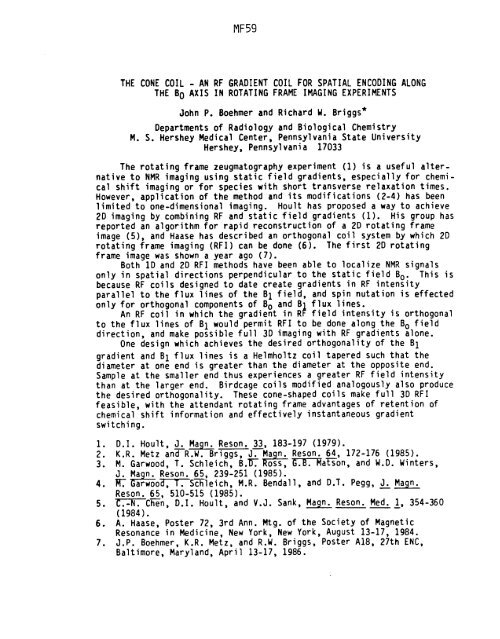th - 1987 - 51st ENC Conference
th - 1987 - 51st ENC Conference
th - 1987 - 51st ENC Conference
Create successful ePaper yourself
Turn your PDF publications into a flip-book with our unique Google optimized e-Paper software.
MF59<br />
THE CONE COIL - AN RF GRADIENT COIL FOR SPATIAL <strong>ENC</strong>ODING ALONG<br />
THE B 0 AXIS IN ROTATING FRAME IMAGING EXPERIMENTS<br />
John P. Boehmer and Richard W. Briggs*<br />
Departments of Radiology and Biological Chemistry<br />
M. S. Hershey Medical Center, Pennsylvania State University<br />
Hershey, Pennsylvania 17033<br />
The rotating frame zeugmatography experiment (1) is a useful alternative<br />
to NMR imaging using static field gradients, especially for chemical<br />
shift imaging or for species wi<strong>th</strong> short transverse relaxation times.<br />
However, application of <strong>th</strong>e me<strong>th</strong>od and its modifications (2-4) has been<br />
limited to one-dimensional imaging. Hoult has proposed a way to achieve<br />
2D imaging by combining RF and static field gradients (1). His group has<br />
reported an algori<strong>th</strong>m for rapid reconstruction of a 2D rotating frame<br />
image (5), and Haase has described an or<strong>th</strong>ogonal coil system by which 2D<br />
rotating frame imaging (RFI) can be done (6). The first 2D rotating<br />
frame image was shown a year ago (7).<br />
Bo<strong>th</strong> ID and 2D RFI me<strong>th</strong>ods have been able to localize NMR signals<br />
only in spatial directions perpendicular to <strong>th</strong>e static field B o. This is<br />
because RF coils designed to date create gradients in RF intensity<br />
parallel to <strong>th</strong>e flux lines of <strong>th</strong>e B 1 field, and spin nutation is effected<br />
only for or<strong>th</strong>ogonal components of B o and B I flux lines.<br />
An RF coil in which <strong>th</strong>e gradient in RF field intensity is or<strong>th</strong>ogonal<br />
to <strong>th</strong>e flux lines of B 1 would permit RFI to be done along <strong>th</strong>e B o field<br />
direction, and make possible full 3D imaging wi<strong>th</strong> RF gradients alone.<br />
One design which achieves <strong>th</strong>e desired or<strong>th</strong>ogonality of <strong>th</strong>e B 1<br />
gradient and B 1 flux lines is a Helmholtz coil tapered such <strong>th</strong>at <strong>th</strong>e<br />
diameter at one end is greater <strong>th</strong>an <strong>th</strong>e diameter at <strong>th</strong>e opposite end.<br />
Sample at <strong>th</strong>e smaller end <strong>th</strong>us experiences a greater RF field intensity<br />
<strong>th</strong>an at <strong>th</strong>e larger end. Birdcage coils modified analogously also produce<br />
<strong>th</strong>e desired or<strong>th</strong>ogonality. These cone-shaped coils make full 3D RFI<br />
feasible, wi<strong>th</strong> <strong>th</strong>e attendant rotating frame advantages of retention of<br />
chemical shift information and effectively instantaneous gradient<br />
switching.<br />
I. D.I. Hoult, J. Magn. Reson. 33, 183-197 (1979).<br />
2. K.R. Metz and R.W. Briggs, J. Ma_~g~_n. Reson. 64, 172-176 (1985).<br />
3. M. Garwood, T. Schleich, B.~Ross, ~]~]--~a~on, and W.D. Winters,<br />
J. Magn. Reson. 65, 239-251 (1985).<br />
4. I~. ~o~-T]-. S~leich, M.R. Bendall, and D.T. Pegg, J__s. Magn.<br />
Reson. 65, 510-515 (1985).<br />
5. ~C~n, D.I. Hoult, and V.J. Sank, Magn. Reson. Med. i, 354-360<br />
(1984).<br />
6. A. Haase, Poster 72, 3rd Ann. Mtg. of <strong>th</strong>e Society of Magnetic<br />
Resonance in Medicine, New York, New York, August 13-17, 1984.<br />
7. J.P. Boehmer, K.R. Metz, and R.W. Briggs, Poster A18, 27<strong>th</strong> <strong>ENC</strong>,<br />
Baltimore, Maryland, April 13-17, 1986.













